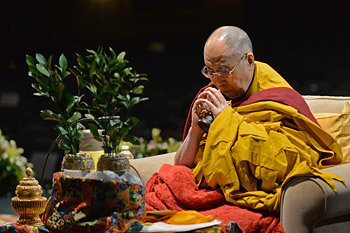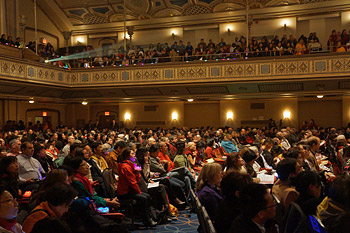New York, NY, USA, 2 November 2014 - Strong cold winds blew under the steely light of early winter as His Holiness the Dalai Lama drove through New York, down along the Hudson River, to the Manhattan Center this morning. He had been invited by the Danang Foundation led by Karma Kagyu Lama, Tsewang Tashi Rinpoche, to teach Nagarjuna’s ‘Commentary on the Awakening Mind’ and bestow a One-thousand Armed Avalokiteshvara Empowerment. Of the 1100 people filling the theater, 800 were Chinese from the Chinese mainland, Hong Kong, Taiwan, Singapore, Malaysia and North America. They were joined by Tibetans, Mongolians and Americans.

|
His Holiness the Dalai Lama performs preparatory rituals for the Avalokiteshvara Empowerment in the morning before the start of the teachings at the Manhattan Center in New York City on November 2, 2014. Photo/Sonam Zoksang
|
His Holiness arrived early while the theater was still empty to perform preparatory rituals for the empowerment. At the appointed time he took his seat on the teaching throne before large scroll paintings of Buddha Shakyamuni and Nagarjuna, surrounded by venerable monks and nuns from Chinese and Tibetan traditions. Speaking Tibetan translated into Mandarin, he explained that they would begin with a recitation of the Heart Sutra in Chinese followed by verses of salutation to the Buddha and the Heart Sutra mantra.
“In this world, in general, human beings have a right to acquire happiness and avoid suffering,” His Holiness began. “And as we evolved, firstly in response to fear and danger, we developed thoughts of religion based on faith and hope. In due course we elaborated these thoughts with philosophical ideas, developing theistic and non-theistic traditions. Buddhism, along with a branch of the Samkhyas and Jainism, is one of the non-theistic traditions. However, Buddhism is the only tradition to teach a theory of no-self.”
His Holiness explained that the Buddha’s first teaching, the first turning of the wheel of dharma, consisted of an explanation of the Four Noble Truths. This instruction is common to all traditions of Buddhism in both the Pali and Sanskrit traditions. The Four Noble Truths, with their 16 characteristics and the 37 wings of enlightenment form the basis of all the later teachings of the Buddha. They would have been taught in the existing Indian vernacular language and were eventually recorded first in Pali.
The ‘Unravelling of Thought Sutra’ describes three turnings of the wheel of dharma among which the second involved the teachings of the Perfection of Wisdom. The ‘Unravelling of Thought Sutra’ is popular in China and there is a commentary to it in Chinese. Consequently, some Chinese traditions tend towards the Mind Only school of thought. Because Buddhism first reached China in the 3rd and 4th centuries CE, His Holiness refers to the Chinese as the senior disciples. Tibetans first encountered Buddhism in the 7th century and it was established in Tibet in 8th century. This was done principally by Shantarakshita, a leading Buddhist master from Nalanda University. He was a bhikshu, an eminent Vinaya holder, a thinker, a proponent of his own school of Madhyamaka philosophy and a logician.

|
Some of the 1100 people attending His Holiness the Dalai Lama's teachings at the Manhattan Center in New York City on November 2, 2014. Photo/Jeremy Russell/OHHDL
|
Buddhist masters following Nagarjuna in 2nd century, such as Aryadeva, Bhavaviveka, Chandrakirti and Shantideva in their philosophical writings routinely surveyed, reviewed and criticized other schools of Indian thought. Shantarakshita, a holder of Dignaga’s and Dharmakirti’s traditions of logic and epistemology, followed the same pattern. This approach, meeting the challenge of other schools of thought, is what helped Buddhism develop. Only Tibetan Buddhism deals with logic and epistemology, which is little found in the Pali or Chinese traditions.
“Of the Buddha’s activities of body, speech and mind,” His Holiness explained, “the most important were his teachings, his acts of speech. I often half-jokingly say that while it is very good to build temples and statues to express our respect for the Buddha, those images will never speak. On the other hand, the Tibetan canon possesses 100 volumes recording the Buddha’s teachings and the Chinese canon does likewise. We should translate and exchange texts between our traditions and study them.
“Although I don’t know very much,” His Holiness averred, “I can try to explain what I think is important among the Buddha’s teachings. One of the common explanations of enlightened activity of the Buddha’s speech refers to method and wisdom. Method includes the lineage of vast activities outlined by Maitreya, while the profound view expounded by Nagarjuna refers to wisdom. Nagarjuna asserted that whatever the Buddha taught is founded on the basis of the two truths, conventional and ultimate. Essentially, things don’t exist as they appear to.”
His Holiness referred to a prayer in Chinese that says, ‘May I dispel the three poisons’, which entails countering the disturbing emotions. The most effective way of doing that is to cultivate wisdom, the direct antidote to ignorance, so the next line is, “May the light of wisdom arise in me’. The third line is, ‘May all internal and external obstacles be eliminated’ and it ends, ‘May I enter into the practices of a Bodhisattva’.

|
His Holiness the Dalai Lama speaking during his teachings at the Manhattan Center in New York City on November 2, 2014. Photo/Jeremy Russell/OHHDL
|
Turning to the text, the ‘Commentary on the Awakening Mind’, he said some researchers have questioned its attribution to Nagarjuna because it is not cited by any of his disciples. Others confirm his authorship. It surveys the views of other schools much as does the ‘Precious Garland of Advice for a King’. His Holiness said he had received the oral transmission of the text from Tri Rinpoche, Rizong Rinpoche, but that there did not appear to be a corresponding tradition of commentary to it. However, he felt confident that if Nagarjuna were alive, he would be happy to see His Holiness teaching it, rather as if the text had been dormant and His Holiness had woken it up.
He read the first nearly 40 verses, stopping here and there to make clarifications. Those listening were able to follow him in a booklet that contained Tibetan, Chinese and English renditions of the text. Then remarking that while in reality food has no inherent existence any more than those who eat it, food nevertheless can satisfy hunger, so he suggested it was time for lunch.
Continuing to read in the afternoon, His Holiness cited verse 48 as epitomizing the meaning of the text:
Therefore constantly meditate on this emptiness:
The basis of all phenomena,
Tranquil and illusion-like,
Groundless and destroyer of cyclic existence.
At the end His Holiness urged his listeners to the read what they had heard again and again, to read slowly and reflect on what they read. At the beginning of the Avalokiteshvara empowerment he remarked that it is the subtle mind that transforms into the wisdom body of a Buddha. As part of the preparation of the disciples he stressed their need to correct their motivation. The proper motivation for receiving the empowerment is not a wish for wealth or longevity, but a wish to attain Buddhahood for the sake of all sentient beings. As part of the proceedings he led the gathering in generating the awakening mind of bodhichitta and taking the bodhisattva vows.
At the conclusion, a line of Chinese women, each holding an illuminated lotus flower, gathered in front of the stage to chant prayers of dedication and requests for His Holiness to live long. 